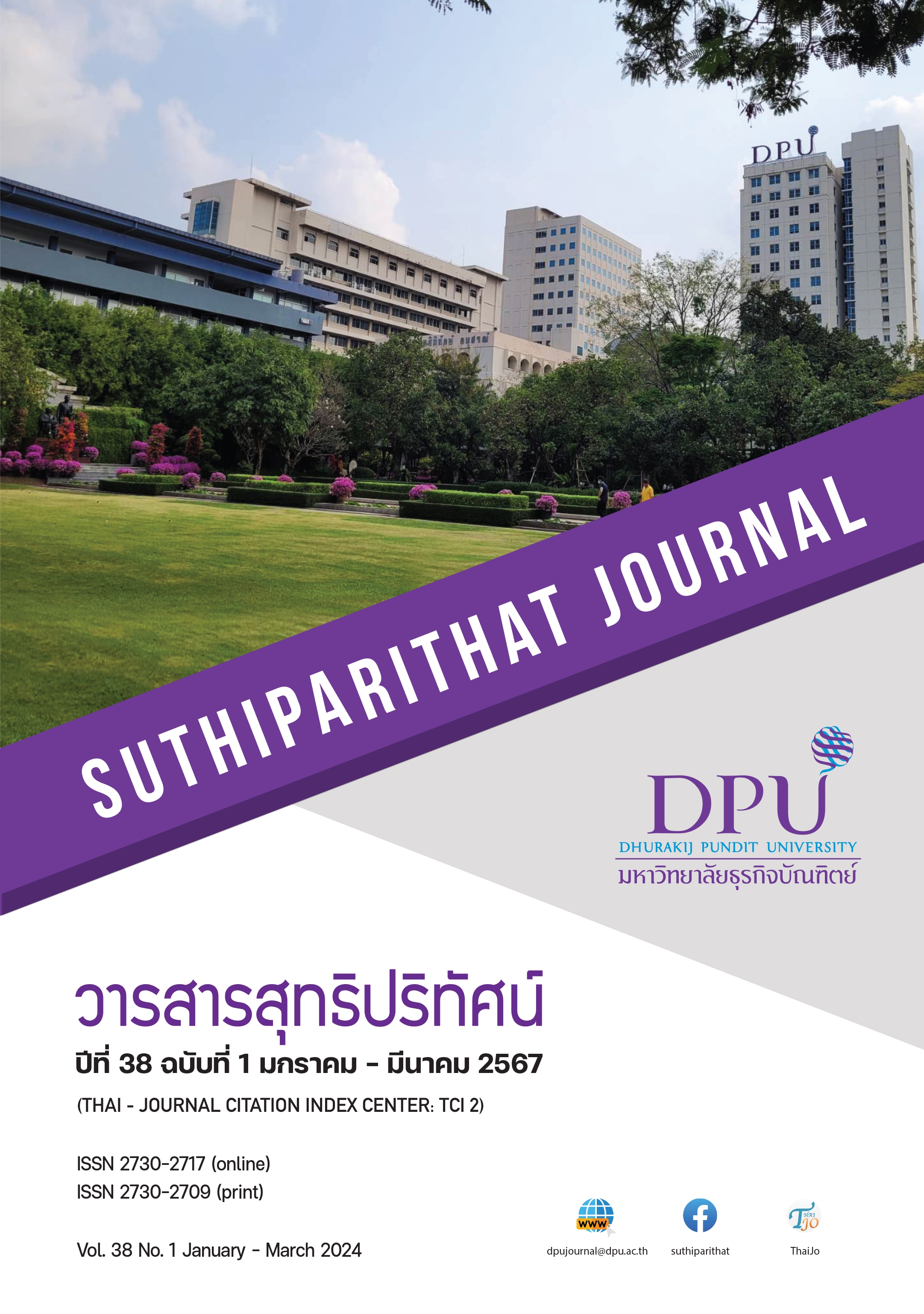ปัจจัยที่มีอิทธิพลต่ออัตราเงินปันผลตอบแทนของบริษัทที่จดทะเบียนในตลาดหลักทรัพย์แห่งประเทศไทยดัชนี SET100
คำสำคัญ:
เงินปันผลตอบแทน, ขนาดคณะกรรมการบริษัท, ตลาดหลักทรัพย์แห่งประเทศไทยบทคัดย่อ
การวิจัยครั้งนี้มีจุดมุ่งหมายเพื่อศึกษาปัจจัยที่มีอิทธิพลต่ออัตราเงินปันผลตอบแทนของบริษัทที่จดทะเบียนในตลาดหลักทรัพย์แห่งประเทศไทย ดัชนี SET100 กลุ่มตัวอย่างที่ใช้ในการวิจัย คือ บริษัทที่จดทะเบียนในตลาดหลักทรัพย์แห่งประเทศไทยที่อยู่ในดัชนี SET100 ย้อนหลัง 5 ปี ตั้งแต่ปี 2561-2565 จำนวน 80 บริษัท รวมทั้งสิ้น 400 กลุ่มข้อมูล โดยไม่รวมกลุ่มอุตสาหกรรมธุรกิจการเงินจำนวน 20 บริษัท โดยเก็บรวมรวมข้อมูลจากรายงานทางการเงิน รายงานประจำปี รวมทั้งรายงานผลการดำเนินงานในแบบ 56-1 สถิติที่ใช้ในการวิเคราะห์ข้อมูล คือ สถิติเชิงพรรณนา ได้แก่ ค่าเฉลี่ย ค่าส่วนเบี่ยงเบนมาตรฐาน ค่าต่ำสุด ค่าสูงสุด สถิติเชิงอนุมาน ได้แก่ การวิเคราะห์สัมประสิทธิ์สหสัมพันธ์ และการวิเคราะห์การถดถอยพหุคูณ ผลการวิจัยพบว่า อัตราส่วนหนี้สินต่อส่วนของผู้ถือหุ้น (DE) อัตราผลตอบแทนต่อสินทรัพย์รวม (ROA) อัตรากำไรสุทธิ (NI) ขนาดของคณะกรรมการบริษัท (BOD) และตัวแปรควบคุม อายุของกิจการ (AGE) มีอิทธิพลต่ออัตราเงินปันผลตอบแทนของบริษัทที่จดทะเบียนในตลาดหลักทรัพย์แห่งประเทศไทยดัชนี 100 ผลลัพธ์ที่ได้นี้มีประโยชน์ต่อนักลงทุนเพื่อนำไปใช้ในการพิจารณาก่อนลงทุน อีกทั้งผู้บริหารธุรกิจยังสามารถนำไปใช้ไปในการวางแผนธุรกิจเพื่อให้เกิดผลประโยชน์ต่อการดำเนินงานได้ต่อไปในอนาคต
เอกสารอ้างอิง
ชลวิช สุธัญญารักษ์. (2560). ความเสี่ยงและอัตราผลตอบแทนของหลักทรัพย์หมวดการท่องเที่ยวและสันทนาการ โดยใช้แบบจำลอง CAPM. วารสารบัณฑิตศึกษา มหาวิทยาลัยราชภัฏวไลยอลงกรณ์ ในพระบรมราชูปถัมภ์, 11(3), 13-23. https://so02.tci-thaijo.org/index.php/JournalGradVRU/article/view/108212
ตลาดหลักทรัพย์แห่งประเทศไทย. (2566, 1 ตุลาคม). ภาพรวมดัชนี SET100 – ตลาดหลักทรัพย์แห่งประเทศไทย. https://www.set.or.th/th/market/index/SET100/overview
ธันยกร จันทร์สาส์น. (2559). คุณภาพกำไรของบริษัทจดทะเบียนในประเทศไทยที่มีบรรษัทภิบาลในระดับดีเลิศ: นับจากรายการคงค้าง. วารสารนักบริหาร, 36(2), 52-61. https://so01.tci-thaijo.org/index.php/executivejournal/article/view/81352
นภสินธุ์ สานติวัตร และ สรศาสตร์ สุขเจริญสิน. (2564). การศึกษาความสัมพันธ์ระหว่างการจ่ายเงินปันผลและการเปลี่ยนแปลงของกำไรในอนาคต. จุฬาลงกรณ์ธุรกิจปริทัศน์, 43(169), 1-21. https://so01.tci-thaijo.org/index.php/CBSReview/article/view/250228
นิกข์นิภา บุญช่วย และ สุพรรณิกา สันป่าแก้ว. (2561). ปัจจัยที่มีผลต่อการจ่ายเงินปันผลของกลุ่มหลักทรัพย์ในตลาดหลักทรัพย์แห่งประเทศไทย กรณีศึกษา กลุ่มหลักทรัพย์พลังงานและสาธารณูปโภค. Veridian E-Journal, Silpakorn University (Humanities, Social Sciences and arts), 11(2), 1870-1879. https://he02.tci-thaijo.org/index.php/Veridian-E-Journal/article/view/143277
ปราญชลี สมภพโคภาเศรษฐ์. (2559). โครงสร้างผู้ถือหุ้น คณะกรรมการบริษัท กับนโยบายการจ่ายเงินปันผล [การค้นคว้าอิสระปริญญามหาบัณฑิต, มหาวิทยาลัยธรรมศาสตร์]. TU Digital Collections. https://digital.library.tu.ac.th/tu_dc/frontend/Info/item/dc:93070
วิวัฒน์วงศ์ บุญหนุน. (2565). ปัจจัยที่มีอิทธิพลต่อดัชนีราคาตลาดหลักทรัพย์แห่งประเทศไทย: กรณีศึกษาหลักทรัพย์กลุ่มเกษตรและอุตสาหกรรมอาหาร. วารสารบริหารศาสตร์ มหาวิทยาลัยอุบลราชธานี, 11(2), 18-32. https://so03.tci-thaijo.org/index.php/jms_ubu/article/view/254958
ศุภลักษณ์ อังคสุโข, ผาติกา ตันวิเชียร, ตระการตา สงวนศักดิ์โยธิน, และ ปิยภัสร ธาระวานิช. (2555). นโยบายการจ่ายเงินปันผลกับความไม่แน่นอนของกระแสเงินสด (Cash flow uncertainty) และลักษณะโครงสร้างผู้ถือหุ้น (Ownership structure). จุฬาลงกรณ์ธุรกิจปริทัศน์, 34(131), 107-144. https://so01.tci-thaijo.org/index.php/CBSReview/article/view/3879
สันติ์สุภา ลัคนาภิเศรษฐ์, ศิริลักษณ์ ศุทธชัย, และ นภาพร ลิขิตวงศ์ขจร. (2562). ความสัมพันธ์ระหว่างสิทธิในการซื้อหุ้นที่ให้กับผู้บริหารกับความสามารถในการทำกำไร. วารสารวิชาชีพบัญชี, 15(47), 32-48. http://www.jap.tbs.tu.ac.th/index.php?page=Article-List&sub=1&txt=554
สุกัญญา วงษ์ลคร และ จักรกฤษณ์ มะโหฬาร. (2566). อัตราส่วนทางการเงิน โครงสร้างคณะกรรมการกับผลการดำเนินงานของบริษัทจดทะเบียนในตลาดหลักทรัพย์แห่งประเทศไทย ดัชนี CLMV. วารสารสุทธิปริทัศน์, 37(1), 109-127. https://so05.tci-thaijo.org/index.php/DPUSuthiparithatJournal/article/view/263402
Ajanthan, A. (2013). The relationship between dividend payout and firm profitability: A study of selected hotels and restaurant companies in Sri Lanka. International Journal of Scientific and Research Publications, 3(6), 1-6. https://www.academia.edu/6183546/the_relationship_between_dividend_payout_and_firm_profitibility_In_Sri_Lanka_
Al-Kayed, L. T. (2017). Dividend payout policy of Islamic vs conventional banks: Case of Saudi Arabia. International Journal of Islamic and Middle Eastern Finance and Management, 10(1), 117-128. https://doi.org/10.1108/IMEFM-09-2015-0102
Atmikasari, D., Indarti, I., & Aditya, E. M. (2020). Pengaruh Profitabilitas terhadap Nilai Perusahaan dengan Kebijakan Deviden sebagai Variabel Intervening. Jurnal Ilmiah ASET, 22(1), 25–34. https://doi.org/10.37470/1.22.1.158
Baker, H. K., Powell, G. E., & Veit, E. T. (2002). Revisiting managerial perspectives on dividend policy. Journal of Economics and Finance, 26(3), 267-283. https://doi.org/10.1007/BF02759711
Bowerman, B. L., & O’Connell, R. T. (1990). Linear statistical models: An applied approach (2nd ed.). Duxbury Press.
Brigham, E. F., & Houston, D. (2019). Intermediate financial management (13th ed.). South-Westtern Cengage Learning.
DeAngelo, H. L., & Stulz, R. M. (2006). Dividend policy and the earned/contributed capital mix: A test of the life-cycle theory. Journal of Financial Economics, 81(2), 227-254. http://dx.doi.org/10.1016/j.jfineco.2005.07.005
Ephraim, K. T., & Sylvester, A. M. (2022). The impact of board composition on the dividend policy of US Firms. Corporate Governance: The International Journal of Business in Society, 21(5), 737-753. https://doi.org/10.1108/CG-05-2020-0182
Fama, E. F., & French, K. R. (2001). Disappearing dividends: Changing firm characteristics or lower propensity to pay?. Journal of Financial Economics, 60(1), 3-43. http://dx.doi.org/10.1016/s0304-405x(01)00038-1
Farinha, J. (2003). Dividend policy, corporate governance and the managerial entrenchment hypothesis: An empirical analysis. Journal of Business Finance & Accounting, 30(9-10), 1173-1209. https://doi.org/10.1111/j.0306-686X.2003.05624.x
Hinkle, D. E. (1998). Applied statistics for the behavioral sciences. Houghton Mifflin.
Jensen, M. C., & Meckling, W. H. (1976). Theory of the firm: Managerial behavior agency costs and ownership structure. Journal of Financial Economics, 3(4), 305-360. https://doi.org/10.1016/0304-405X(76)90026-X
Khan, F., & Ahmad, N. (2017). Determinants of dividend payout: An empirical study of pharmaceutical companies of Pakistan Stock Exchange (PSX). Journal of Financial Studies & Research, Article 5382141-16. http://dx.doi.org/10.5171/2017.538821
Mahdzan, N. S., Zainudin, R., & Shahri, N. K. (2016). Interindustry dividend policy determinants in the context of an emerging market. Economic Research-Ekonomska Istrzivanja, 29(1), 250-262. http://dx.doi.org/10.1080/1331677X.2016.1169704
Malik, M., Awais, M., & Khursheed, A. (2016). Impact of liquidity on profitability: A comprehensive case of Pakistan’s private banking sector. International Journal of Economics and Finance, 8(2), 69-74. http://dx.doi.org/10.5539/ijef.v8n3p69
Myers, R. H. (1990). Classical and modern regression with applications. PWS-Kent.
Oonpipat, O. (2009). Dividend policy and earned/contributed capital mix: The empirical study of Thailand [Master’ s thesis, Thammasat University]. TU Digital Collections. https://digital.library.tu.ac.th/tu_dc/frontend/Info/item/dc:148337
Parsian, H., & Koloukhi, S. (2014). A Study on the effect of free cash flow and profitability current ratio on dividend payout ratio: Evidence from Tehran Stock Exchange. Management Science Letters, 4(1), 63-70. http://dx.doi.org/10.5267/j.msl.2013.11.033
Pinto, G., & Rastogi, S. (2019). Sectoral analysis of factors influencing dividend policy: Case of an emerging financial market. Journal of Risk and Financial Management, 12(3), 1-18. http://dx.doi.org/10.3390/jrfm12030110
Pornumpai, K., & Phassawan, S. (2013). Factors influencing dividend payout in Thailand: A tobit regression analysis. International Journal of Accounting and Financial Reporting, 3(2), 255. http://dx.doi.org/10.5296/ijafr.v3i2.4443
Pradika, R., & Rediyono, R. (2022). Factors affecting dividend policy: Study on food and beverage manufacturing sector companies listed on the Indonesia Stock Exchange. International Journal of Economics and Financial, 12(4), 91-96. http://dx.doi.org/10.32479/ijefi.13198
Putra, R. C., & Dillak, V. J. (2018). Analisis pengaruh debt to equity ratio (der), return on equity (roe), dan earning per share (eps) terhadap harga saham (studi Kasus Pada Indeks saham subsektor pertambangan yang terdaftar di bursa efek Indonesia periode 2012-2016). E-Proceeding of Management, 5(2), 2079-2085. https://openlibrarypublications.telkomuniversity.ac.id/index.php/management/article/view/6775
Sawicki, J. (2009). Corporate governance and dividend policy in Southeast Asia pre and post crisis. The European Journal of Finance, 15(2), 211-230. https://doi.org/10.1080/13518470802604440
Schellenger, M. H., Wood, D. D., & Tashakori, A. (1989). Board of director composition, shareholder wealth, and dividend policy. Journal of Management, 15(3), 457-467. https://doi.org/10.1177/014920638901500308
Schooley, D. K., & Barney, L. D. (1994). Using dividend policy and managerial ownership to reduce agency costs. Journal of Financial Research, 17(3), 363-373. https://doi.org/10.1111/j.1475-6803.1994.tb00198.x
Subramaniam, R., & Sakthi, M. (2022). Board performance and its relation to dividend payout: Evidence from Malaysia. International Journal of Managerial Finance, 18(2), 286-316. https://doi.org/10.1108/IJMF-08-2020-0409
Zarah, P. (2018). Ability of net income in predicting dividend yield operating cash flow as a moderating variable. Archives of Business Research, 6(1), 226-234. http://dx.doi.org/10.14738/abr.61.4128
Zarah, P. (2019). Empirical evidence of market reactions based on signaling theory in Indonesia stock exchange. Investment Management and Financial Innovations, 16(2), 66-77. http://dx.doi.org/10.21511/imfi.16(2).2019.06
ดาวน์โหลด
เผยแพร่แล้ว
รูปแบบการอ้างอิง
ฉบับ
ประเภทบทความ
สัญญาอนุญาต
ลิขสิทธิ์ (c) 2024 มหาวิทยาลัยธุรกิจบัณฑิตย์

อนุญาตภายใต้เงื่อนไข Creative Commons Attribution-NonCommercial-NoDerivatives 4.0 International License.
เนื้อหาและข้อมูลในบทความที่ลงตีพิมพ์ในวารสารสุทธิปริทัศน์ ถือเป็นข้อคิดเห็นและความรับผิดชอบของผู้เขียนบทความโดยตรงซึ่งกองบรรณาธิการวารสาร ไม่จำเป็นต้องเห็นด้วย หรือร่วมรับผิดชอบใด ๆ
บทความ ข้อมูล เนื้อหา รูปภาพ ฯลฯ ที่ได้รับการตีพิมพ์ในวารสารสุทธิปริทัศน์ ถือเป็นลิขสิทธิ์ของวารสารสุทธิปริทัศน์หากบุคคลหรือหน่วยงานใดต้องการนำทั้งหมดหรือส่วนหนึ่งส่วนใดไปเผยแพร่ต่อหรือเพื่อกระทำการใด ๆ จะต้องได้รับอนุญาตเป็นลายลักษณ์อักษรจากวารสารสุทธิปริทัศน์ก่อนเท่านั้น







